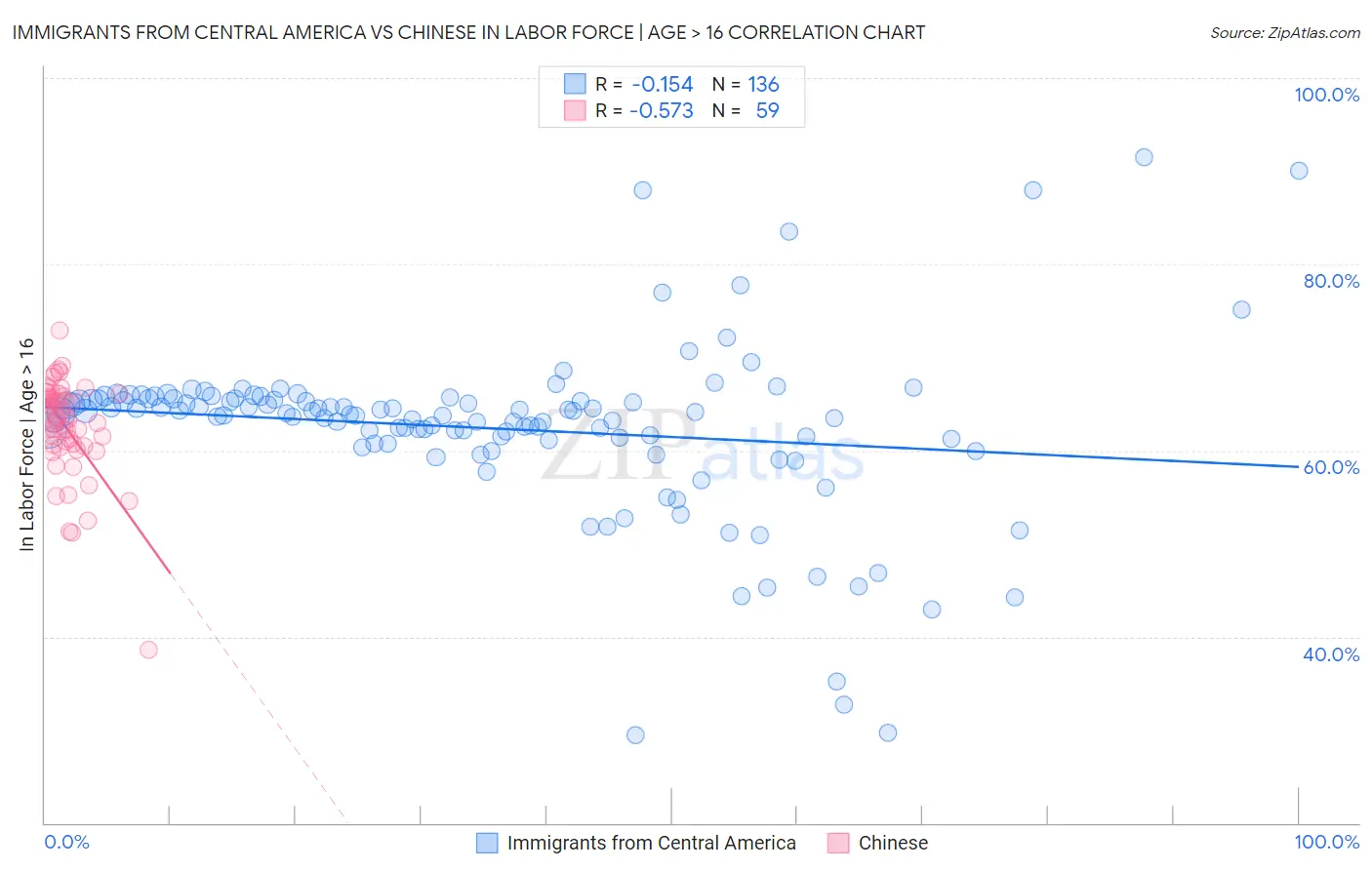Immigrants from Central America vs Chinese In Labor Force | Age > 16
COMPARE
Immigrants from Central America
Chinese
In Labor Force | Age > 16
In Labor Force | Age > 16 Comparison
Immigrants from Central America
Chinese
64.7%
IN LABOR FORCE | AGE > 16
10.5/ 100
METRIC RATING
219th/ 347
METRIC RANK
64.7%
IN LABOR FORCE | AGE > 16
7.3/ 100
METRIC RATING
230th/ 347
METRIC RANK
Immigrants from Central America vs Chinese In Labor Force | Age > 16 Correlation Chart
The statistical analysis conducted on geographies consisting of 536,509,301 people shows a poor negative correlation between the proportion of Immigrants from Central America and labor force participation rate among population ages 16 and over in the United States with a correlation coefficient (R) of -0.154 and weighted average of 64.7%. Similarly, the statistical analysis conducted on geographies consisting of 64,809,883 people shows a substantial negative correlation between the proportion of Chinese and labor force participation rate among population ages 16 and over in the United States with a correlation coefficient (R) of -0.573 and weighted average of 64.7%, a difference of 0.11%.

In Labor Force | Age > 16 Correlation Summary
| Measurement | Immigrants from Central America | Chinese |
| Minimum | 29.4% | 38.6% |
| Maximum | 91.5% | 72.9% |
| Range | 62.1% | 34.3% |
| Mean | 62.4% | 62.4% |
| Median | 64.0% | 63.3% |
| Interquartile 25% (IQ1) | 61.2% | 60.5% |
| Interquartile 75% (IQ3) | 65.5% | 65.9% |
| Interquartile Range (IQR) | 4.3% | 5.4% |
| Standard Deviation (Sample) | 9.3% | 5.4% |
| Standard Deviation (Population) | 9.3% | 5.4% |
Demographics Similar to Immigrants from Central America and Chinese by In Labor Force | Age > 16
In terms of in labor force | age > 16, the demographic groups most similar to Immigrants from Central America are Alsatian (64.7%, a difference of 0.010%), Belgian (64.7%, a difference of 0.020%), U.S. Virgin Islander (64.7%, a difference of 0.020%), Alaska Native (64.7%, a difference of 0.020%), and Immigrants from Micronesia (64.7%, a difference of 0.030%). Similarly, the demographic groups most similar to Chinese are British (64.7%, a difference of 0.0%), Immigrants from Northern Europe (64.7%, a difference of 0.0%), European (64.7%, a difference of 0.040%), Polish (64.7%, a difference of 0.040%), and Northern European (64.7%, a difference of 0.040%).
| Demographics | Rating | Rank | In Labor Force | Age > 16 |
| Estonians | 13.1 /100 | #214 | Poor 64.8% |
| Immigrants | Czechoslovakia | 12.3 /100 | #215 | Poor 64.8% |
| Belgians | 11.4 /100 | #216 | Poor 64.7% |
| U.S. Virgin Islanders | 11.3 /100 | #217 | Poor 64.7% |
| Alsatians | 10.7 /100 | #218 | Poor 64.7% |
| Immigrants | Central America | 10.5 /100 | #219 | Poor 64.7% |
| Alaska Natives | 9.9 /100 | #220 | Tragic 64.7% |
| Immigrants | Micronesia | 9.6 /100 | #221 | Tragic 64.7% |
| Hawaiians | 9.3 /100 | #222 | Tragic 64.7% |
| Immigrants | Belize | 9.2 /100 | #223 | Tragic 64.7% |
| Immigrants | Jamaica | 8.8 /100 | #224 | Tragic 64.7% |
| Croatians | 8.8 /100 | #225 | Tragic 64.7% |
| Europeans | 8.3 /100 | #226 | Tragic 64.7% |
| Poles | 8.3 /100 | #227 | Tragic 64.7% |
| Northern Europeans | 8.2 /100 | #228 | Tragic 64.7% |
| British | 7.3 /100 | #229 | Tragic 64.7% |
| Chinese | 7.3 /100 | #230 | Tragic 64.7% |
| Immigrants | Northern Europe | 7.2 /100 | #231 | Tragic 64.7% |
| Africans | 5.8 /100 | #232 | Tragic 64.6% |
| Slavs | 4.9 /100 | #233 | Tragic 64.6% |
| Vietnamese | 4.7 /100 | #234 | Tragic 64.6% |